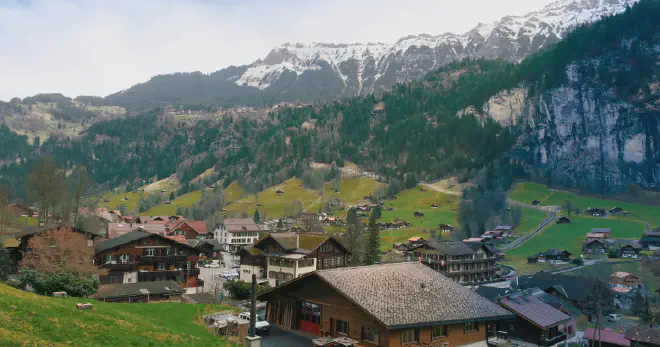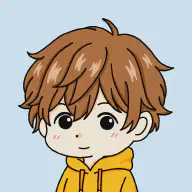Introduction
Interlaken, nestled in the heart of Switzerland’s Bernese Oberland, is a town whose very name means “between lakes” - a fitting description for this beautiful settlement. Cradled between two azure jewels, Lake Thun and Lake Brienz, with the majestic trio of Jungfrau, Eiger, and Mönch - peaks soaring over 3,000 meters - rising dramatically behind it.
This small town has served as the gateway to Alpine tourism since the 19th century, captivating visitors from around the world. Though situated in the German-speaking region, English is widely understood here, creating a harmonious blend of Swiss tradition and international atmosphere. Sprawling green meadows at 564 meters above sea level, timber chalet houses dotting the landscape, and above all, the magnificent Alpine peaks visible from every corner create the distinctive character of this land.
Whether skiing in winter or hiking in summer, Interlaken offers year-round natural splendor. I visited during early summer, when Alpine snowmelt nourished the lakes and wildflowers bloomed in riotous color across the landscape - a season of incomparable beauty.

Day 1: Embraced by Lakeside Tranquility
The train journey from Zurich Airport to Interlaken Ost was like a compressed essence of Swiss beauty. Through the window, I watched rolling green hills, scattered red-roofed houses, and mountain ridges that grew ever more imposing. When the train began following Lake Thun’s shoreline, the emerald waters sparkled in the sunlight, and across the lake, orderly vineyards climbed the opposite slopes.
I arrived at Interlaken Ost station around 2 PM. The station building, with its typical Swiss timber construction and beautifully arranged heavy tiles, immediately set the tone. From the station forecourt, Jungfrau’s summit was already peeking through the clouds, its majesty stopping me in my tracks.
My accommodation was a small family hotel along Höheweg. The elderly gentleman at reception, speaking English with a charming German accent, kindly provided directions, and from my room window, I could see the Aare River and the mountains beyond. After settling in, I ventured out to explore the town.
Interlaken’s center is small enough to walk comfortably, with Höheweg as the main street lined with souvenir shops and restaurants. Particularly striking was a shop specializing in traditional Swiss products, displaying handcrafted wood carvings, alphorns, and colorful handkerchiefs embroidered with Swiss flags. The elderly shopkeeper explained the merchandise in fluent English, speaking passionately about wood carving techniques.
Toward evening, I visited Höhematte, a vast grass park in the town center. Despite its central location, building construction is prohibited here, allowing for unobstructed views of endless green carpet stretching toward towering mountains. Tourists and locals relaxed leisurely, while children’s voices calling after soccer balls echoed through the peaceful afternoon air.
Sitting on the grass, sipping water from my bottle while gazing at Jungfrau’s peak, I felt time suspend itself. Completely removed from urban chaos, I realized how small I was before nature’s grandeur. Yet somehow, my heart felt utterly fulfilled.
For dinner, I visited “Restaurant Taverne,” recommended by a local. I ordered raclette, a traditional Swiss dish. The special apparatus brought to my table allowed me to melt cheese while pouring it over potatoes. The rich, creamy cheese flavor filled my mouth, providing simple yet profound satisfaction. Watching a cheerful local family at the neighboring table, I felt the warmth of Swiss hospitality.
Returning to the hotel, the Alpine peaks were painted by sunset, with delicate pink alpenglow coloring the sky. Opening my room window, cool mountain air flowed in, and faintly, cowbell chimes drifted from the distance. Such profound silence had been absent from my life for far too long.
Day 2: Gateway to the World Above the Clouds
Breakfast was served in the hotel’s cozy dining room. The Swiss-style morning meal was beautifully simple and delicious - fresh croissants, various cheeses and ham, and local honey arranged on wooden tables. The morning mountains visible through the window showed a completely different face from the previous evening, with mist threading through valleys in an ethereal display.
The day’s main event was a journey by cogwheel train to Jungfraujoch. I planned to reach this station at 3,454 meters, called the “Top of Europe.” Around 9 AM, I boarded the mountain railway from Interlaken Ost via Lauterbrunnen to Kleine Scheidegg.
The carriages featured elegant wood interiors with large windows designed to maximize scenic enjoyment. As the train gained altitude, the landscape below transformed continuously. Beginning with verdant pastures, transitioning through coniferous forests, to finally revealing steep rocky peaks.
At Lauterbrunnen, I glimpsed the famous Staubbach Falls through the carriage window. Cascading 300 meters down sheer cliffs in a single white ribbon, it was truly nature’s artwork. I understood why literary giants like Goethe and Wordsworth cherished this place.
At Kleine Scheidegg, I transferred to the Jungfrau Railway. Here began the genuine journey into high Alpine territory. The train passed through tunnels carved from solid rock, with brief stops at Eigergletscher and Eismeer stations. At Eismeer station, viewing windows offered close encounters with glaciers, and I gasped at the blue-tinged ice world.
I reached Jungfraujoch around noon. Stepping from the station, I entered another world entirely. Despite midsummer, everything was covered in snow and ice, with air so pure that each breath filled my lungs with crystalline freshness.
The 360-degree panorama from the Sphinx Observatory was overwhelming. The Aletsch Glacier flowed majestically, while distant peaks of the Matterhorn and Mont Blanc were visible. Every tourist seemed struck speechless by this grandeur. I too leaned against the observatory railing, absorbed in the spectacle.
I also toured the Ice Palace. This cave carved from the Aletsch Glacier was illuminated in blue light, displaying ice sculptures. The cold transmitted through the floor and the sound of water droplets from walls testified to nature’s immense power.
Late afternoon, before boarding the descent train, I had a light lunch at the station restaurant. Surprisingly sophisticated for a mountain location, it served dishes using local ingredients. From my window seat, I could see the observatory I’d just visited, confirming that this extraordinary experience was real.
Returning to Interlaken in the evening, I explored Lake Brienz’s shoreline. Unlike Lake Thun, Brienz displayed deeper blue waters, with mountain reflections creating mystical patterns. A small boat dock lined the shore, where a local elderly man peacefully enjoyed fishing.
For dinner at a lakeside restaurant, I ordered perch meunière. This locally caught freshwater fish was delicate and refined, with exquisite butter sauce pairing. I chose local white wine from Valais canton, savoring it slowly while gazing across the lake.
That night, writing in my journal in the hotel room, I reflected on the day’s intensity. I had awakened to lakeside tranquility in the morning, been overwhelmed by nature’s grandeur in the clouds at midday, and spent peaceful evening hours by the water again. Such diverse experiences within a single day exemplified Interlaken’s unique position. The mountains were shrouded in night, with stars shining brilliantly overhead.
Day 3: A Final Morning Etched in Memory
On my final morning, I woke earlier than usual. Looking outside, thin mist hung over the Aare River, creating a fantastical scene. Not wanting to miss this beautiful moment, I grabbed my camera and stepped outside.
The morning walk was a special time. Few tourists were about, with only occasional locals walking their dogs. Along the riverside path, people greeted me with “Grüezi” (Swiss German greeting), reminding me again of the local warmth.
Morning dew sparkled on Höhematte’s grass, while the mountains glowed divinely in sunrise light. Sitting on a bench, eating a fresh croissant from the bakery, I reflected on these three days. This journey had provided deep natural connection impossible in urban life.
During the morning, I decided to take the cable car to Harder Kulm, which I hadn’t yet visited. This viewpoint, accessible in about 10 minutes from Interlaken town, offered panoramic views of the entire town, both lakes, and the backdrop mountains.
The cable car climbed steep gradients, with Interlaken’s townscape shrinking below through the windows. Arriving at Harder Kulm at 1,322 meters, a 360-degree panorama awaited.
The view from the observatory was breathtakingly beautiful, clearly showing how Lake Thun and Lake Brienz embraced the town like outstretched arms. Jungfrau, Eiger, and Mönch stood majestically, with verdant rolling hills spreading before them. This was a fresh experience of viewing from above the scenery I had been looking up at from ground level.
The observatory included a restaurant where I ordered the specialty Harder Potato. Though a simple dish using local potatoes, eating it while enjoying this spectacular view made it taste exceptional. An elderly Swiss couple at the neighboring table struck up conversation in fluent English, teaching me about Interlaken’s history and hidden spots. Their love for their homeland came through clearly in our conversation.
Around noon, I returned by cable car and headed to the town center for final shopping. At a small shop dealing Swiss watches, I purchased a travel memento. The shopkeeper spoke enthusiastically about watchmaking traditions, offering glimpses into Swiss craftsmanship spirit.
Lunch was at a small family-run café I’d noticed on the first day. I ordered their signature Älplermagronen (Swiss-style gratin). Though simple in appearance, this dish of onions, bacon, and abundant cheese was deeply flavorful - truly the taste of Swiss home cooking. The elderly café owner spoke broken English, asking friendly questions about where I came from and my impressions of Switzerland.
Having time before departure, I spent my final afternoon relaxing once more at Höhematte. Lying on the grass and looking skyward, white clouds slowly crossed mountain peaks. Bird songs, distant cowbell chimes, and occasional mountain train whistles mixed together, creating Interlaken’s distinctive soundscape.
Around 3 PM, I returned to pack at the hotel. When returning my key at the front desk, the receptionist said, “Please come again.” Though my stay was brief, there had indeed been genuine heart connections with the local people.
Waiting for my train at Interlaken Ost station, I felt genuine reluctance to leave. Even from the platform, Jungfrau’s majestic form was visible, and memories from these three days vividly returned. When the train arrived and I took a window seat, looking back, Interlaken town gradually grew smaller. The mountains maintained their dignity to the end, seeing the traveler off.
Conclusion
This three-day, two-night journey to Interlaken, though imaginary, felt like a genuine experience.
The Alps’ magnificent nature, lakeside tranquility, spectacular views from mountain railways, warm interactions with locals, and traditional Swiss cuisine flavors - all these remain deeply etched in my heart. Particularly impressive was Swiss culture’s natural harmony between modern convenience and traditional values.
From Jungfraujoch’s glaciers to Höhematte’s grass, experiencing nearly 3,000 meters of altitude variation in a single day is possible in few places worldwide. Most importantly, the profound silence and peace I could feel everywhere healed a heart weary from daily life.
Interlaken is a special place where natural beauty and human activity achieve perfect harmony, offering deep emotion and peace to visitors. Through this journey, I gained renewed appreciation for nature’s greatness and the wisdom of people who have carefully preserved it.
Though an imaginary journey, the landscapes, sounds, scents, flavors, and human encounters that remain in my heart are as vivid as if actually experienced. Perhaps this is because Interlaken’s special charm and the warmth of its people provided reality beyond imagination.

